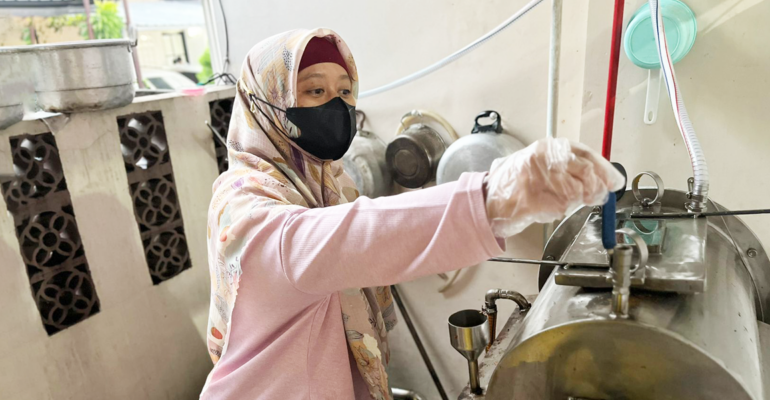IPB University Students Develop Appropriate Technology for Rendang Cooking

A total of five IPB University students successfully developed a rendang cooking machine for micro, small and medium enterprises (MSMEs). This appropriate technology is called the Cylinder Vacuum Cooker. Unlike the stove and pot in general, this rendang cooking tool uses a vacuum cooking system in a cooking tube equipped with an automatic stirrer.
The five students are Fitroh Agung Dimas Tetuko (Department of Management), Lingga Fauzyan Firdhaus and Arwanila Sartika Tri Febianti (Department of Mechanical Engineering and Biosystems), Farhan Al-Ghifari from Agronomy and Horticulture and Hanin Nur Azizah (Department of Food Technology). The five students were accompanied by Dr Faleh Setia Budi, IPB University lecturer (Department of Food Technology).
Hanin Nur Azizah, said the rendang cooking machine uses the vacuum principle to lower the pressure in the cooking tube so that the boiling point in the tube will decrease. She believes that this particular technique for cooking preserves both the nutritional and sensory characteristics of rendang meat.
Furthermore, she claims that vacuum machine settings will speed up the drying of moisture content in food products. This is because the air within the cooking tube has been absorbed by the vacuum system. This type of situation will additionally result in a reduced duration for cooking because the point at which it boils of the water will go down as the air pressure drops.
“Cooking rendang that originally took 4-5 hours with a capacity of five kilograms of meat, with this tool it only takes 3 hours with a capacity of six kilograms of meat,” said Hanin Nur Azizah, IPB university student.
Hanin continued, apart from increasing capacity and reducing production time, this machine is also able to reduce employee wages because the work is made easier. In the past, the owner had to pay an initial labour wage of Rp 30,000 per kilogram of meat, but nowadays they only pay Rp 10,000 per kilogram.
“The explanation for why rendang has been chosen as the primary dish that could be cooked with a machine like this is that its preparation involves an extremely long period for cooking. This makes it extremely prone to nutrient decline as well as sensory alterations all through the preparation and cooking process,” said Hanin.
Fitroh and his colleagues expect that this type of technology may be commercialised in order for its positive effects to be taken advantage of by all rendang entrepreneurs. (IAAS/ASB)


